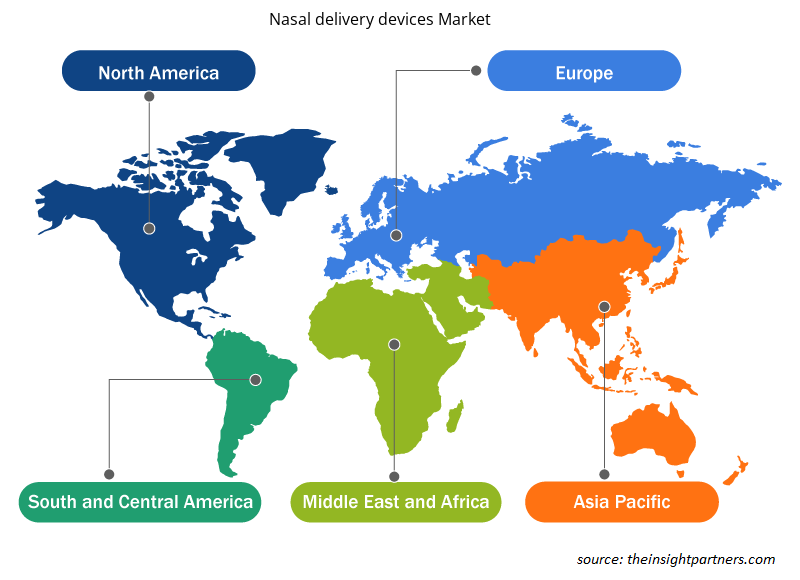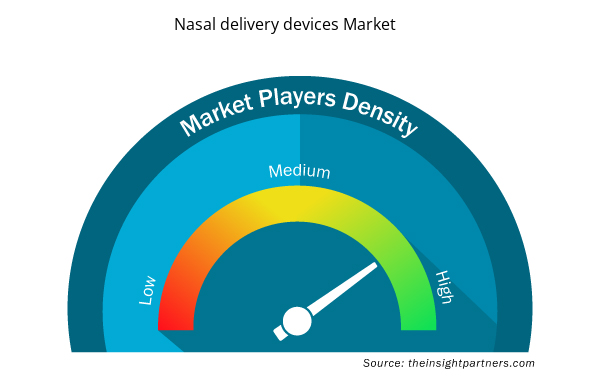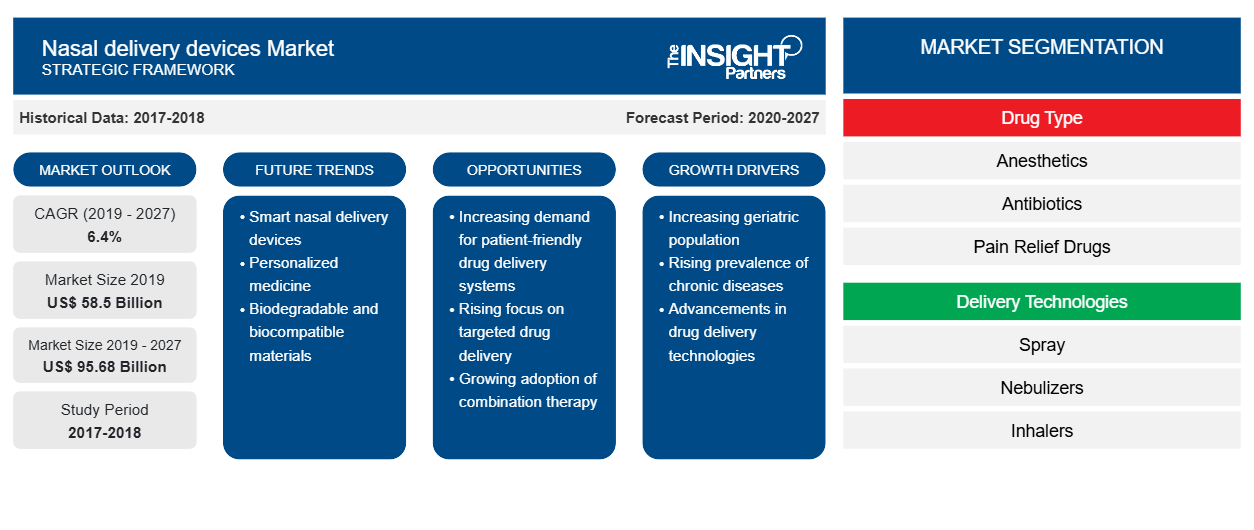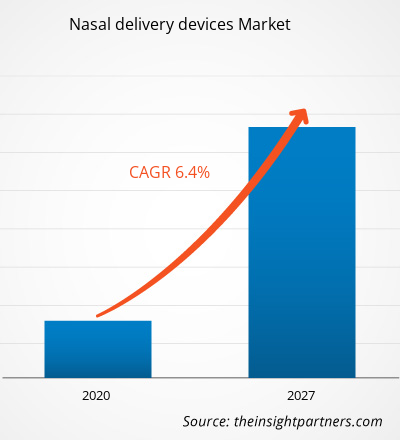経鼻投与装置市場は、2019年の585億218万米ドルから2027年には956億7662万米ドルに達すると予想されています。市場は2020年から2027年にかけて6.4%のCAGRで成長すると予測されています。
鼻腔内薬物送達は、患者だけでなく医療従事者の間でも最も好まれる薬物送達経路の 1 つです。これは主に、この送達経路の非侵襲性と鼻腔内経路を介した薬物の吸収性の高さに起因します。さらに、鼻腔内経路は胃腸内経路に比べて薬物にとって過酷な環境ではないため、薬物の吸収性が向上します。これらの薬物の投与が容易であることは、患者の薬物療法へのコンプライアンスを向上させる上で重要な役割を果たし、ひいては患者の転帰を促進します。これらの要因を考慮すると、鼻腔内薬物送達に対する患者だけでなく医療従事者の間でも好まれるようになっています。鼻腔は血管が密集しているため、薬物の吸収が促進され、作用が速くなります。世界保健機関 (WHO) は、製造業者向けの特定のガイドラインを策定しており、使い捨て送達システムを備えた新しい鼻腔内送達デバイスの採用に必要なすべての要件を概説しています。したがって、鼻腔内薬物送達は、他の薬物送達経路とは異なり、体内に薬物を投与するための厳格な無菌方法を必要としません。このように、鼻腔内薬剤投与の利点に関する認識の高まりにより、患者と医療提供者の間で鼻腔内薬剤投与に対する高い選好が市場の成長を牽引しています。
要件に合わせてレポートをカスタマイズする
このレポートの一部、国レベルの分析、Excelデータパックなど、あらゆるレポートを無料でカスタマイズできます。また、スタートアップや大学向けのお得なオファーや割引もご利用いただけます。
- このレポートの主要な市場動向を入手してください。この無料サンプルには、市場動向から見積もりや予測に至るまでのデータ分析が含まれます。
市場分析
呼吸器系および中枢神経系疾患の増加
新たな経鼻薬物送達デバイスを使用した初期の概念実証研究では、呼吸器疾患、神経疾患などの治療において有望な結果が示されました。薬物送達デバイスは、鼻腔内の標的部位に薬物全体を送達する上で重要な役割を果たします。過去数十年で、血液脳関門 (BBB) を通過する際の課題を克服できる可能性のある革新的な薬物送達アプローチがいくつか導入されました。いくつかの科学的研究は、経鼻経路による薬物送達により、より高濃度の薬物が BBB を通過できる可能性があるという推測を裏付けています。神経疾患の発生率の上昇により、経鼻送達デバイスの需要が増加すると考えられます。米国臨床腫瘍学会 (ASCO) によると、2020 年に米国では 0~14 歳の小児で約 3,540 件の脳腫瘍およびその他の CNS 腫瘍が診断されています。報告書ではまた、脳腫瘍やその他の中枢神経系腫瘍は小児がんの中で2番目に多いがんで、15歳未満の小児がん症例の約26%を占めていると述べられている。
急性下気道感染症、結核、慢性閉塞性肺疾患(COPD - 気管支炎や肺気腫を含む疾患スペクトラム)、喘息、肺がんなどの呼吸器疾患は、世界中で深刻な病気や死亡の最も一般的な原因に数えられています。都市化の進行と汚染、不健康なライフスタイルと習慣、喫煙率の高さは、呼吸器疾患と心血管疾患の症例急増につながる要因に数えられます。呼吸器疾患は急性呼吸不全を引き起こす可能性があり、その治療には継続的なサポートのための経鼻薬剤投与が必要です。Global Asthma Networkが発行した「Global Asthma Report 2018」によると、世界で約3億3千万人が喘息を患っています。さらに、健康指標評価研究所の特別研究プロジェクトである世界疾病負担の推定によると、2016年には約42万人が喘息で亡くなりました。 2018年に米国国立医学図書館国立衛生研究所で発表された研究によると、韓国では喘息の有病率が一貫して高く、特に女性と高齢者層で高いことが示されています。さらに、世界疾病負担研究報告書によると、2016年のCOPD症例の有病率は2億5,100万人でした。COPDによる死亡者の90%以上は低中所得国(LMIC)で発生しており、この疾患は今後15年間で世界の主要な死因になる可能性があります。
したがって、呼吸器疾患、神経疾患、その他の慢性疾患の有病率の増加により、標的部位への効果的な薬物送達のための経鼻送達デバイスの需要が高まっています。
薬剤タイプに関する洞察
薬剤の種類に基づいて、経鼻投与装置市場は、麻酔薬、抗生物質、鎮痛薬、カルシウム補給剤、血管収縮薬、抗ヒスタミン薬、その他に分類されます。2019 年には、抗ヒスタミン薬セグメントが市場で最大のシェアを占めました。このセグメントの成長は、アレルギー性鼻炎の増加に起因しています。
配信テクノロジーの洞察
送達技術に基づいて、世界の鼻腔送達デバイス市場は、スプレー、ネブライザー、吸入器、その他に分類されます。2019 年には、吸入器セグメントが市場の大きなシェアを占め、予測期間中に市場で最も高い CAGR を記録すると予想されています。
エンドユーザーの洞察
エンドユーザーに基づいて、世界の経鼻デリバリーデバイス市場は、在宅ケア環境、病院、および診療所に分類されます。2019 年には、在宅ケア環境セグメントが市場の大きなシェアを占め、予測期間中に市場で最も高い CAGR を記録すると予想されています。
製品の発売と承認は、企業が世界的な足跡と製品ポートフォリオを拡大し、高まる消費者の需要を満たすために一般的に採用されている戦略です。鼻腔デリバリーデバイス市場のプレーヤーは、コラボレーション戦略を採用して世界中の顧客基盤を拡大し、それによってブランド名を世界的に維持することもできます。
経鼻デリバリーデバイス市場地域別インサイト
予測期間を通じて鼻腔デリバリーデバイス市場に影響を与える地域的な傾向と要因は、Insight Partners のアナリストによって徹底的に説明されています。このセクションでは、北米、ヨーロッパ、アジア太平洋、中東、アフリカ、南米、中米にわたる鼻腔デリバリーデバイス市場のセグメントと地理についても説明します。

- 経鼻投与デバイス市場の地域別データを入手
経鼻デリバリーデバイス市場レポートの範囲
| レポート属性 | 詳細 |
|---|---|
| 2019年の市場規模 | 585億米ドル |
| 2027年までの市場規模 | 956.8億米ドル |
| 世界のCAGR(2019年 - 2027年) | 6.4% |
| 履歴データ | 2017-2018 |
| 予測期間 | 2020-2027 |
| 対象セグメント | 薬の種類別
|
| 対象地域と国 | 北米
|
| 市場リーダーと主要企業プロフィール |
|
経鼻デリバリーデバイス市場のプレーヤー密度:ビジネスダイナミクスへの影響を理解する
鼻腔デリバリーデバイス市場は、消費者の嗜好の変化、技術の進歩、製品の利点に対する認識の高まりなどの要因により、エンドユーザーの需要が高まり、急速に成長しています。需要が高まるにつれて、企業は提供を拡大し、消費者のニーズを満たすために革新し、新たなトレンドを活用し、市場の成長をさらに促進しています。
市場プレーヤー密度とは、特定の市場または業界内で活動している企業または会社の分布を指します。これは、特定の市場スペースに、その規模または総市場価値と比較して、どれだけの競合相手 (市場プレーヤー) が存在するかを示します。
経鼻デリバリーデバイス市場で事業を展開している主要企業は次のとおりです。
- グラクソ・スミスクライン
- アストラゼネカ
- ファイザー株式会社
- BD
- サノフィ
免責事項:上記の企業は、特定の順序でランク付けされていません。

- 鼻腔デリバリーデバイス市場のトップキープレーヤーの概要を入手
経鼻投与デバイス市場 – 薬剤タイプ別
- 麻酔薬
- 抗生物質
- 鎮痛薬
- カルシウムサプリメント
- 血管収縮薬
- 抗ヒスタミン薬
- その他
経鼻デリバリーデバイス市場 – デリバリー技術別
- スプレー
- ネブライザー
- 吸入器
- その他
経鼻デリバリーデバイス市場 – エンドユーザー別
- ホームケア設定
- 病院
- クリニック
経鼻デリバリーデバイス市場 – 地域別
- 北米
- 私たち
- カナダ
- メキシコ
- ヨーロッパ
- フランス
- ドイツ
- イタリア
- 英国
- スペイン
- その他のヨーロッパ
- アジア太平洋(APAC)
- 中国
- インド
- 韓国
- 日本
- オーストラリア
- その他のアジア太平洋地域
- 中東・アフリカ(MEA)
- 南アフリカ
- サウジアラビア
- アラブ首長国連邦
- その他の中東およびアフリカ
- 南米と中央アメリカ
- ブラジル
- アルゼンチン
- 南米のその他の地域
企業プロフィール
- グラクソ・スミスクライン
- アストラゼネカ
- ファイザー株式会社
- BD
- サノフィ
- メルク社
- カディラ製薬株式会社
- ノバルティスAG
- レディ博士の研究所
- ニューレリス株式会社
- 過去2年間の分析、基準年、CAGRによる予測(7年間)
- PEST分析とSWOT分析
- 市場規模価値/数量 - 世界、地域、国
- 業界と競争環境
- Excel データセット



Report Coverage
Revenue forecast, Company Analysis, Industry landscape, Growth factors, and Trends

Segment Covered
This text is related
to segments covered.

Regional Scope
North America, Europe, Asia Pacific, Middle East & Africa, South & Central America

Country Scope
This text is related
to country scope.
よくある質問
The nasal delivery devices market majorly consists of the players such as GlaxoSmithKline plc.,AstraZeneca, Pfizer Inc., BD, Sanofi, Merck & Co., Inc., Cadila Pharmaceuticals Ltd., Novartis AG, Dr. Reddy's Laboratories, and Neurelis. amongst others.
The factors that are driving growth of the market are growing prevalence of respiratory and cns diseases and increasing preference and awareness of intranasal drug delivery among patients.Moreover, strategic activities by the manufacturersare offering lucrative opportunities for the growth of the market.
Nasal drug delivery is one of the efficient route of drug administration. It offers needle-free drug delivery, optimal route for brain-targeted therapies, and superior bioavailability. Nasal route of administration is preferred in several disease indications such as Parkinson’s disease, prostate cancer, migraine, and influenza amongst others. Moreover, nasal route is also suitable for the treatment of drug addiction as well as for sedation.
Trends and growth analysis reports related to Life Sciences : READ MORE..
The List of Companies - Nasal delivery devices Market
- GlaxoSmithKline plc.
- AstraZeneca
- Pfizer Inc.
- BD
- Sanofi
- Merck & Co., Inc.
- Cadila Pharmaceuticals Ltd.
- Novartis AG
- Dr. Reddy's Laboratories
- Neurelis, Inc.
The Insight Partners performs research in 4 major stages: Data Collection & Secondary Research, Primary Research, Data Analysis and Data Triangulation & Final Review.
- Data Collection and Secondary Research:
As a market research and consulting firm operating from a decade, we have published and advised several client across the globe. First step for any study will start with an assessment of currently available data and insights from existing reports. Further, historical and current market information is collected from Investor Presentations, Annual Reports, SEC Filings, etc., and other information related to company’s performance and market positioning are gathered from Paid Databases (Factiva, Hoovers, and Reuters) and various other publications available in public domain.
Several associations trade associates, technical forums, institutes, societies and organization are accessed to gain technical as well as market related insights through their publications such as research papers, blogs and press releases related to the studies are referred to get cues about the market. Further, white papers, journals, magazines, and other news articles published in last 3 years are scrutinized and analyzed to understand the current market trends.
- Primary Research:
The primarily interview analysis comprise of data obtained from industry participants interview and answers to survey questions gathered by in-house primary team.
For primary research, interviews are conducted with industry experts/CEOs/Marketing Managers/VPs/Subject Matter Experts from both demand and supply side to get a 360-degree view of the market. The primary team conducts several interviews based on the complexity of the markets to understand the various market trends and dynamics which makes research more credible and precise.
A typical research interview fulfils the following functions:
- Provides first-hand information on the market size, market trends, growth trends, competitive landscape, and outlook
- Validates and strengthens in-house secondary research findings
- Develops the analysis team’s expertise and market understanding
Primary research involves email interactions and telephone interviews for each market, category, segment, and sub-segment across geographies. The participants who typically take part in such a process include, but are not limited to:
- Industry participants: VPs, business development managers, market intelligence managers and national sales managers
- Outside experts: Valuation experts, research analysts and key opinion leaders specializing in the electronics and semiconductor industry.
Below is the breakup of our primary respondents by company, designation, and region:

Once we receive the confirmation from primary research sources or primary respondents, we finalize the base year market estimation and forecast the data as per the macroeconomic and microeconomic factors assessed during data collection.
- Data Analysis:
Once data is validated through both secondary as well as primary respondents, we finalize the market estimations by hypothesis formulation and factor analysis at regional and country level.
- Macro-Economic Factor Analysis:
We analyse macroeconomic indicators such the gross domestic product (GDP), increase in the demand for goods and services across industries, technological advancement, regional economic growth, governmental policies, the influence of COVID-19, PEST analysis, and other aspects. This analysis aids in setting benchmarks for various nations/regions and approximating market splits. Additionally, the general trend of the aforementioned components aid in determining the market's development possibilities.
- Country Level Data:
Various factors that are especially aligned to the country are taken into account to determine the market size for a certain area and country, including the presence of vendors, such as headquarters and offices, the country's GDP, demand patterns, and industry growth. To comprehend the market dynamics for the nation, a number of growth variables, inhibitors, application areas, and current market trends are researched. The aforementioned elements aid in determining the country's overall market's growth potential.
- Company Profile:
The “Table of Contents” is formulated by listing and analyzing more than 25 - 30 companies operating in the market ecosystem across geographies. However, we profile only 10 companies as a standard practice in our syndicate reports. These 10 companies comprise leading, emerging, and regional players. Nonetheless, our analysis is not restricted to the 10 listed companies, we also analyze other companies present in the market to develop a holistic view and understand the prevailing trends. The “Company Profiles” section in the report covers key facts, business description, products & services, financial information, SWOT analysis, and key developments. The financial information presented is extracted from the annual reports and official documents of the publicly listed companies. Upon collecting the information for the sections of respective companies, we verify them via various primary sources and then compile the data in respective company profiles. The company level information helps us in deriving the base number as well as in forecasting the market size.
- Developing Base Number:
Aggregation of sales statistics (2020-2022) and macro-economic factor, and other secondary and primary research insights are utilized to arrive at base number and related market shares for 2022. The data gaps are identified in this step and relevant market data is analyzed, collected from paid primary interviews or databases. On finalizing the base year market size, forecasts are developed on the basis of macro-economic, industry and market growth factors and company level analysis.
- Data Triangulation and Final Review:
The market findings and base year market size calculations are validated from supply as well as demand side. Demand side validations are based on macro-economic factor analysis and benchmarks for respective regions and countries. In case of supply side validations, revenues of major companies are estimated (in case not available) based on industry benchmark, approximate number of employees, product portfolio, and primary interviews revenues are gathered. Further revenue from target product/service segment is assessed to avoid overshooting of market statistics. In case of heavy deviations between supply and demand side values, all thes steps are repeated to achieve synchronization.
We follow an iterative model, wherein we share our research findings with Subject Matter Experts (SME’s) and Key Opinion Leaders (KOLs) until consensus view of the market is not formulated – this model negates any drastic deviation in the opinions of experts. Only validated and universally acceptable research findings are quoted in our reports.
We have important check points that we use to validate our research findings – which we call – data triangulation, where we validate the information, we generate from secondary sources with primary interviews and then we re-validate with our internal data bases and Subject matter experts. This comprehensive model enables us to deliver high quality, reliable data in shortest possible time.


 このレポートの無料サンプルを入手する
このレポートの無料サンプルを入手する